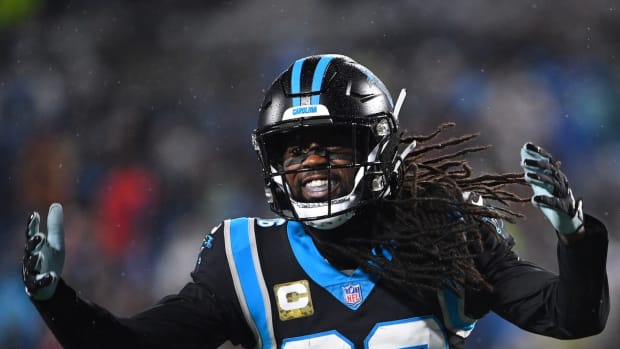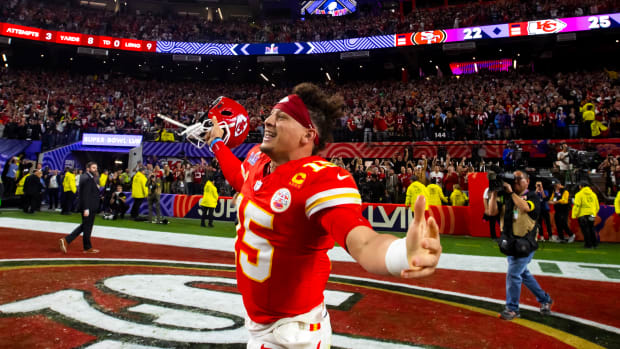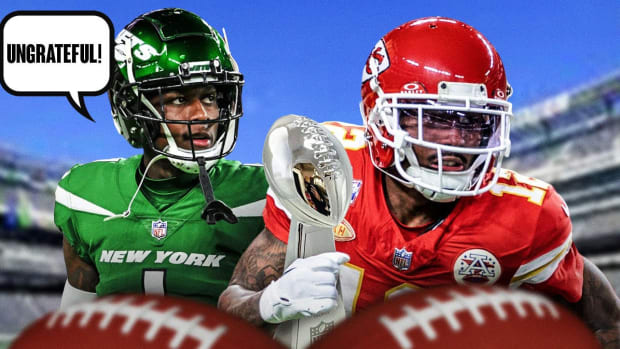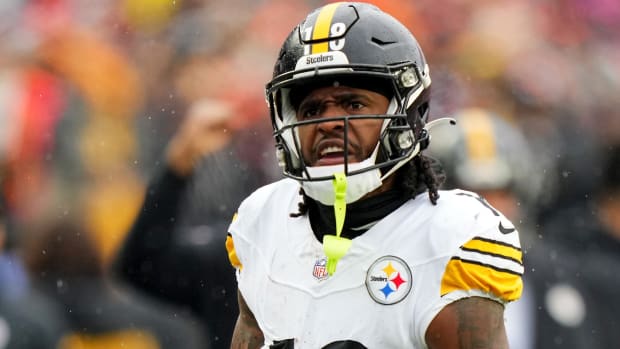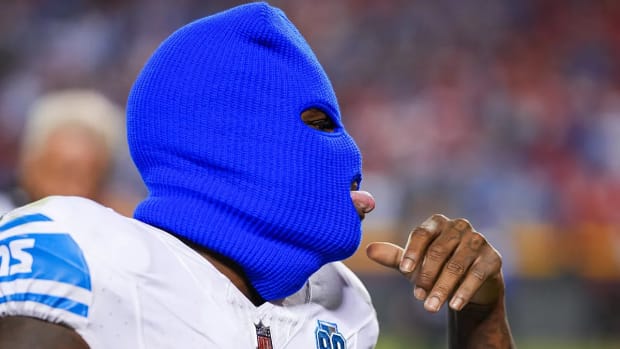Right on time, the Giants resemble the overlooked Super Bowl teams of their past
As Sunday night turned to Monday morning in marginally snowy East Rutherford, N.J.—just minutes removed from the Giants’ predictably unpredictable 10–7 win over the previously surging Cowboys—everything suddenly went dark inside of the home team’s locker room. I mean, literally, all of the lights just went out. And in that transient moment of disorientation, as players hooted and jokingly hollered mild profanities while cloaked in the protection of anonymity, a disembodied voice yelled, presumably in jest, “Get your head out of my ass!”
That was just a colorful transition into this: We have all had our heads in our proverbial rear ends this season. It’s so obvious now. It’s been staring us right in the face all year. This current Giants team is so perplexing, so cognitively dissonant, so good-bad (or bad-good) that they have to win the Super Bowl this year. We’ve seen this story twice before. At this point, it is practically a fait accompli. Statistically, analytically, eye-test-y, whichever way you choose to judge their 2016 campaign, the success they are currently having does not make sense. Yet, at the same time, it makes all the sense.
As the old saying goes: Fool me once, shame on you. Fool me twice, shame on me. Try to fool me a third time, though, and I’ll be on to you by Week 14. Or something like that.
“Obviously you can see the similarities to [the past Super Bowl years],” says receiver Victor Cruz, one of five members of the 2011 championship team still on the Giants’ roster. “Obviously there are some parallels. This team has that same energy, the same resiliency.”
Resiliency is one way to put it. The ability to consistently defy common sense and statistical probability is another. In 2007 New York finished 10–6, about a game and a half better than their expected win-loss total said they should have, according to Pro Football Reference. In ’11 they finished 9–7 (and were actually outscored by opponents during the regular season) despite their “expected” record being sub-.500. In both of those years, the Giants hoisted the Lombardi Trophy, and in both of those years we didn’t see it coming. It blindsided us like a Harry Douglas cut block.
This year, as New York sits at 9–4, their “expected” record is hovering right around .500. They have outscored their opponents by only 11 points and haven’t beaten one by more than six points all year (other than the Browns, but that doesn’t count). In the Cowboys game on Sunday night, their offense was anemic, impuissant, seemingly unable to muster any yards, let alone points. At one point in the second half, their fans gave a sarcastic Bronx cheer after the team simply managed a first down. And yet, they won.
“Right now, it does feel a little similar,” says long-snapper Zak DeOssie, one of only two players on the Giants’ current roster who was on both of their previous two championship teams. “It’s happened twice before. We went the long route to two Super Bowls. But, I guess we should talk in five weeks.”
Well, we don’t have five weeks, Zak. We live in a world of infinitesimal attention spans and an insatiable need for prognostication and instant gratification. No, I am (obviously) not actually guaranteeing a Giants Super Bowl win. But I figured we should take at least look in the way-back machine, just to see how their last two championship seasons stack up with this current squad.
• KING: The NFL is up for grabs | VRENTAS: NFL modifying Pink October initiative
Let’s break it down into four completely arbitrary categories.
Offense
The most surprising thing about the 2016 Giants is that Eli Manning has looked a lot more like ’07 Eli Manning than ’11 Eli Manning. In ’07, Manning, amid his fourth NFL season, was consistently derided and ridiculed—by fans, pundits, the New York tabloids. (These days he’s still the butt of many an internet meme, but it seems to be more in good humor and coming from a place of genuine appreciation.) Despite Manning’s 20 interceptions and 56.1% completion rate, the Giants’ offense still finished 14th in the league in scoring behind a bruising offensive line and the NFL’s fourth-ranked rushing attack. But it was a plodding, one-dimensional offense, built to wear opposing defenses down slowly, by sheer physicality.
In 2011 the Giants made a clear shift to the pass-first unit we see today. Manning had nearly 600 pass attempts, and New York had two receivers with over 1,000 yards. The Giants still had Kevin Gilbride serving as offensive coordinator, so they were still running a system predicated on play-action fakes and deep passing routes. Manning had nearly 5,000 passing yards and 8.4 yards per attempt (both remain career highs), and the offense ranked ninth in the league with nearly 25 points scored per game. The season remains, by many measures, Manning’s best year.
The quarterback’s completion percentage is higher this season (nearing 63%), but that is a byproduct of Ben McAdoo’s spread offense, which emphasizes short crossing routes. Manning has actually regressed this year, compared with his recent seasons, and he hasn’t gotten much help from a makeshift offensive line and the league’s second-least productive rushing attack. (The line should improve once left guard Justin Pugh returns from injury.) An offense that ranked sixth in scoring last year has fallen all the way down to 25th this season, despite promoting the offensive coordinator to head coach.
But when I ask Victor Cruz the biggest difference between the current team and the 2011 Super Bowl team, he simply looks a few feet to his left, where Odell Beckham Jr. is being swarmed by a media horde. “That’s the biggest difference,” Cruz says.
In the Cowboys game, Beckham turned what would have been a seven-yard completion for any other receiver into a 61-yard touchdown. “I had to hit another gear,” Beckham said nonchalantly after the game. The enigmatic receiver’s ability to reach that other gear—which looks very much like Dominic Toretto pushing the NOS button late in a street race—has turned the simple slant route into the Giants’ most dangerous weapon. Beckham will have to continually hit that otherworldly gear to give New York a chance for another Lombardi.
Defense
You might be surprised to hear that the 2007 defense was not really that good in the regular season, allowing 21.9 points per game (17th in the league). The unit was led by coordinator Steve Spagnuolo and a relentless pass rush—Michael Strahan, Osi Umenyiora, Justin Tuck & Co.—who combined for 53 sacks, six more than any other team in the NFL. And in ’11, with Spagnuolo gone, the defensive unit ranked 25th, despite the emergence of Jason Pierre-Paul and his 16.5 sacks. In both years the Giants’ defense went on dominant playoff runs after inconsistent regular seasons.
The 2016 defense—with Spagnuolo back in the fold as of last year—has easily been the most consistent and impressive of all three teams’. After spending $204 million on four defensive free agents in the off-season, New York currently boasts the seventh-ranked unit in the league. Janoris Jenkins has been a revelation as a shutdown corner—the sixth best at his position in the NFL, according to Pro Football Focus’s rankings (with Dominique Rodgers-Cromartie slotting in as No. 11). The addition of tackle Damon Harrison has turned the defense into a top-10 run-stopping unit, the pass rush has rounded into elite form in recent weeks—the Giants’ 26 sacks since Week 6 are the second-most in the league—and second-year Landon Collins has been transmogrified into one of the best and most well-rounded safeties in the league seemingly overnight. (Worth noting: while the loss of Pierre-Paul didn’t seem to adversely affect the unit against the Cowboys on Sunday, it could be a crippling absence for the remainder of the regular season.)
And while Beckham got much of the media love after the win over the Cowboys on Sunday, it was the stingy play of the defense that had kept the game close to begin with—as they have been doing most of the season.
(Potential) Super Bowl Opponent
Throughout New England, Patriots fans have been waking up in cold sweats in recent weeks, having PTSD-like dreams about the possibility of having to face New York in another Super Bowl. The Giants ended the Patriots’ dream undefeated season in 2007, beating the team everyone was already considering the greatest in NFL history. It wasn’t as big of an upset when it happened again in ’11, but New England was 13–3 in the regular season that year, the No. 1 seed in the AFC, and out for revenge. They are the only two blemishes on Tom Brady’s résumé, and probably in his entire life. And with New England prohibitive favorites to represent the AFC in the Super Bowl again this year, it just feels right that it would come against another one of these Giants teams—either for Brady to finally get that monkey off his back, or for history to repeat itself again.
The ‘Count Us Out’ Game
There is a point in every Giants Super Bowl season when the team is completely written off. In 2007, that game came in Week 12, at home, against Minnesota. New York lost 41–17 to a Tarvaris Jackson-led Vikings squad, as Eli Manning threw four interceptions and had three returned for touchdowns. In ’11, New York lost 49–24 to the Saints in Week 12, the third of what would be a four-game losing streak. The Giants’ defense allowed nearly 600 total yards, and their offense fumbled four times.
This year, I’d argue that the low point has yet to come. Sure, they lost three straight games early in the year, but they were all to potential playoff teams, and they lost to the Steelers in Week 13—another playoff contender—but not in demoralizing, throw-in-the-towel-on-the-season fashion. My prediction? That low point comes next week, against the 9–4 Lions at home. A blowout loss in that game and the Giants will have the football world back right where they want them: doubting that they are for real.
“We love the underdog role,” Cruz says, back by his locker after the win over the Cowboys. “We don’t want to be put on that pedestal. We want to come from behind when no one expects us to win and shock the world.”
































